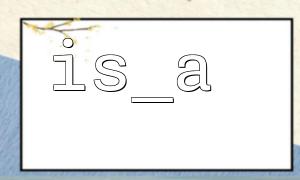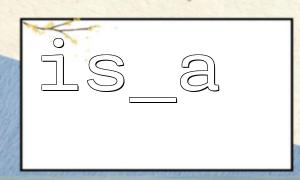在構建現代PHP 應用時,事件驅動架構是一種常見的解耦方式。你可以為系統中某些操作定義事件,然後由監聽器來響應這些事件。在多種事件類型共享監聽器的場景中,如何優雅地判斷某個監聽器是否應該處理某個事件?這正是is_a()函數能大顯身手的地方。
本文將演示如何使用is_a()函數實現一個基於事件類型的分發機制,使得監聽器只處理它“關心”的那類事件。
首先,我們定義一個基礎事件接口和幾個具體事件:
interface EventInterface {}
class UserRegisteredEvent implements EventInterface {
public string $username;
public function __construct(string $username) {
$this->username = $username;
}
}
class OrderPlacedEvent implements EventInterface {
public int $orderId;
public function __construct(int $orderId) {
$this->orderId = $orderId;
}
}
然後我們定義監聽器接口以及一個具體監聽器:
interface EventListenerInterface {
public function handle(EventInterface $event): void;
public function isInterestedIn(EventInterface $event): bool;
}
class SendWelcomeEmailListener implements EventListenerInterface {
public function handle(EventInterface $event): void {
if (!$event instanceof UserRegisteredEvent) return;
// 假設這裡是發送郵件的邏輯
echo "發送歡迎郵件給用戶:{$event->username}\n";
}
public function isInterestedIn(EventInterface $event): bool {
return is_a($event, UserRegisteredEvent::class);
}
}
isInterestedIn()方法就是我們用來進行類型判斷的地方,通過is_a()來判斷傳入的事件是否是監聽器感興趣的類型。
接下來,我們實現一個簡單的事件分發器,它會遍歷所有監聽器,並調用符合條件的監聽器。
class EventDispatcher {
/**
* @var EventListenerInterface[]
*/
private array $listeners = [];
public function addListener(EventListenerInterface $listener): void {
$this->listeners[] = $listener;
}
public function dispatch(EventInterface $event): void {
foreach ($this->listeners as $listener) {
if ($listener->isInterestedIn($event)) {
$listener->handle($event);
}
}
}
}
現在我們可以像下面這樣使用這個分發器:
$dispatcher = new EventDispatcher();
$dispatcher->addListener(new SendWelcomeEmailListener());
$userEvent = new UserRegisteredEvent('Alice');
$orderEvent = new OrderPlacedEvent(1001);
$dispatcher->dispatch($userEvent);
// 輸出:發送歡迎郵件給用戶:Alice
$dispatcher->dispatch($orderEvent);
// 没有輸出,因為監聽器對 OrderPlacedEvent 不感興趣
使用is_a()函數有以下幾個優勢:
清晰的語義:它直接說明了你在判斷類型。
支持繼承:你可以判斷一個對像是否是某個類或其子類的實例,非常適合處理多態事件結構。
靈活性高:可以輕鬆支持多個監聽器監聽不同類型事件,只需更改isInterestedIn()方法即可。
在真實項目中,你可能會希望監聽器通過配置來聲明自己感興趣的事件類型。這時,你可以將事件類名作為字符串保存在監聽器中,再用is_a()比較:
class DynamicListener implements EventListenerInterface {
private string $interestedClass;
public function __construct(string $interestedClass) {
$this->interestedClass = $interestedClass;
}
public function handle(EventInterface $event): void {
echo "處理事件:" . get_class($event) . "\n";
}
public function isInterestedIn(EventInterface $event): bool {
return is_a($event, $this->interestedClass);
}
}
現在你可以動態註冊監聽器,例如:
$dispatcher->addListener(new DynamicListener(UserRegisteredEvent::class));
$dispatcher->addListener(new DynamicListener(OrderPlacedEvent::class));
通過is_a()函數,我們可以優雅地實現事件監聽器的類型判斷邏輯。它為事件驅動系統提供了清晰且靈活的事件過濾機制,尤其適合於多事件類型的分發場景。在構建複雜的系統時,這種模式可以有效解耦業務邏輯,提高系統的可維護性和擴展性。





